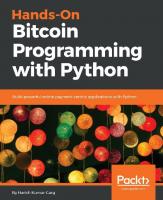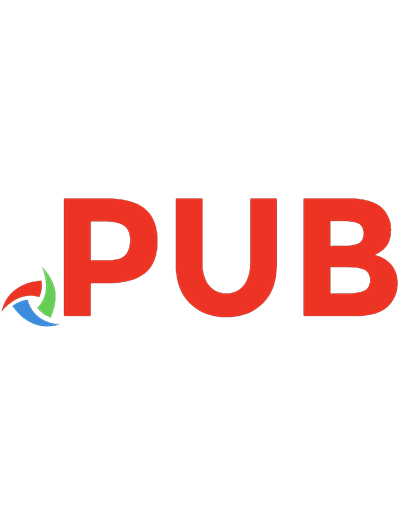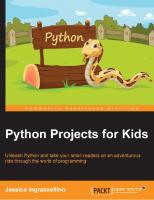Python Real-World Projects: Craft your Python portfolio with deployable applications [1 ed.] 9781803246765
Develop Python applications using an enterprise-based approach with unit and acceptance tests by following agile methods
603 142 9MB
English Pages 515 Year 2023
Table of contents :
Python Real-World Projects
Python Real-World Projects
Python Real-World Projects
Contributors
About the author
About the reviewer
Join our community Discord space
Table of Contents
Preface
Who this book is for
What this book covers
A note on skills required
To get the most out of this book
Complete the extras
Download the example code files
Conventions used
Get in touch
Share your thoughts
Download a free PDF copy of this book
Chapter 1 Project Zero: A Template for Other Projects
1.1 On quality
1.1.1 More Reading on Quality
1.2 Suggested project sprints
1.2.1 Inception
1.2.2 Elaboration, part 1: define done
1.2.3 Elaboration, part 2: define components and tests
1.2.4 Construction
1.2.5 Transition
1.3 List of deliverables
1.4 Development tool installation
1.5 Project 0 – Hello World with test cases
1.5.1 Description
1.5.2 Approach
1.5.3 Deliverables
1.5.4 Definition of done
1.6 Summary
1.7 Extras
1.7.1 Static analysis - mypy, flake8
1.7.2 CLI features
1.7.3 Logging
1.7.4 Cookiecutter
Chapter 2 Overview of the Projects
2.1 General data acquisition
2.2 Acquisition via Extract
2.3 Inspection
2.4 Clean, validate, standardize, and persist
2.5 Summarize and analyze
2.6 Statistical modeling
2.7 Data contracts
2.8 Summary
Chapter 3 Project 1.1: Data Acquisition Base Application
3.1 Description
3.1.1 User experience
3.1.2 About the source data
3.1.3 About the output data
3.2 Architectural approach
3.2.1 Class design
3.2.2 Design principles
3.2.3 Functional design
3.3 Deliverables
3.3.1 Acceptance tests
3.3.2 Additional acceptance scenarios
3.3.3 Unit tests
3.4 Summary
3.5 Extras
3.5.1 Logging enhancements
3.5.2 Configuration extensions
3.5.3 Data subsets
3.5.4 Another example data source
Chapter 4 Data Acquisition Features: Web APIs and Scraping
4.1 Project 1.2: Acquire data from a web service
4.1.1 Description
4.1.2 Approach
4.1.3 Deliverables
4.2 Project 1.3: Scrape data from a web page
4.2.1 Description
4.2.2 About the source data
4.2.3 Approach
4.2.4 Deliverables
4.3 Summary
4.4 Extras
4.4.1 Locate more JSON-format data
4.4.2 Other data sets to extract
4.4.3 Handling schema variations
4.4.4 CLI enhancements
4.4.5 Logging
Chapter 5 Data Acquisition Features: SQL Database
5.1 Project 1.4: A local SQL database
5.1.1 Description
5.1.2 Approach
5.1.3 Deliverables
5.2 Project 1.5: Acquire data from a SQL extract
5.2.1 Description
5.2.2 The Object-Relational Mapping (ORM) problem
5.2.3 About the source data
5.2.4 Approach
5.2.5 Deliverables
5.3 Summary
5.4 Extras
5.4.1 Consider using another database
5.4.2 Consider using a NoSQL database
5.4.3 Consider using SQLAlchemy to define an ORM layer
Chapter 6 Project 2.1: Data Inspection Notebook
6.1 Description
6.1.1 About the source data
6.2 Approach
6.2.1 Notebook test cases for the functions
6.2.2 Common code in a separate module
6.3 Deliverables
6.3.1 Notebook .ipynb file
6.3.2 Executing a notebook’s test suite
6.4 Summary
6.5 Extras
6.5.1 Use pandas to examine data
Chapter 7 Data Inspection Features
7.1 Project 2.2: Validating cardinal domains — measures, counts, and durations
7.1.1 Description
7.1.2 Approach
7.1.3 Deliverables
7.2 Project 2.3: Validating text and codes — nominal data and ordinal numbers
7.2.1 Description
7.2.2 Approach
7.2.3 Deliverables
7.3 Project 2.4: Finding reference domains
7.3.1 Description
7.3.2 Approach
7.3.3 Deliverables
7.4 Summary
7.5 Extras
7.5.1 Markdown cells with dates and data source information
7.5.2 Presentation materials
7.5.3 JupyterBook or Quarto for even more sophisticated output
Chapter 8 Project 2.5: Schema and Metadata
8.1 Description
8.2 Approach
8.2.1 Define Pydantic classes and emit the JSON Schema
8.2.2 Define expected data domains in JSON Schema notation
8.2.3 Use JSON Schema to validate intermediate files
8.3 Deliverables
8.3.1 Schema acceptance tests
8.3.2 Extended acceptance testing
8.4 Summary
8.5 Extras
8.5.1 Revise all previous chapter models to use Pydantic
8.5.2 Use the ORM layer
Chapter 9 Project 3.1: Data Cleaning Base Application
9.1 Description
9.1.1 User experience
9.1.2 Source data
9.1.3 Result data
9.1.4 Conversions and processing
9.1.5 Error reports
9.2 Approach
9.2.1 Model module refactoring
9.2.2 Pydantic V2 validation
9.2.3 Validation function design
9.2.4 Incremental design
9.2.5 CLI application
9.3 Deliverables
9.3.1 Acceptance tests
9.3.2 Unit tests for the model features
9.3.3 Application to clean data and create an NDJSON interim file
9.4 Summary
9.5 Extras
9.5.1 Create an output file with rejected samples
Chapter 10 Data Cleaning Features
10.1 Project 3.2: Validate and convert source fields
10.1.1 Description
10.1.2 Approach
10.1.3 Deliverables
10.2 Project 3.3: Validate text fields (and numeric coded fields)
10.2.1 Description
10.2.2 Approach
10.2.3 Deliverables
10.3 Project 3.4: Validate references among separate data sources
10.3.1 Description
10.3.2 Approach
10.3.3 Deliverables
10.4 Project 3.5: Standardize data to common codes and ranges
10.4.1 Description
10.4.2 Approach
10.4.3 Deliverables
10.5 Project 3.6: Integration to create an acquisition pipeline
10.5.1 Description
10.5.2 Approach
10.5.3 Deliverables
10.6 Summary
10.7 Extras
10.7.1 Hypothesis testing
10.7.2 Rejecting bad data via filtering (instead of logging)
10.7.3 Disjoint subentities
10.7.4 Create a fan-out cleaning pipeline
Chapter 11 Project 3.7: Interim Data Persistence
11.1 Description
11.2 Overall approach
11.2.1 Designing idempotent operations
11.3 Deliverables
11.3.1 Unit test
11.3.2 Acceptance test
11.3.3 Cleaned up re-runnable application design
11.4 Summary
11.5 Extras
11.5.1 Using a SQL database
11.5.2 Persistence with NoSQL databases
Chapter 12 Project 3.8: Integrated Data Acquisition Web Service
12.1 Description
12.1.1 The data series resources
12.1.2 Creating data for download
12.2 Overall approach
12.2.1 OpenAPI 3 specification
12.2.2 RESTful API to be queried from a notebook
12.2.3 A POST request starts processing
12.2.4 The GET request for processing status
12.2.5 The GET request for the results
12.2.6 Security considerations
12.3 Deliverables
12.3.1 Acceptance test cases
12.3.2 RESTful API app
12.3.3 Unit test cases
12.4 Summary
12.5 Extras
12.5.1 Add filtering criteria to the POST request
12.5.3 Use Celery instead of concurrent.futures
12.5.4 Call external processing directly instead of running a subprocess
Chapter 13 Project 4.1: Visual Analysis Techniques
13.1 Description
13.2 Overall approach
13.2.1 General notebook organization
13.2.2 Python modules for summarizing
13.2.3 PyPlot graphics
13.2.4 Iteration and evolution
13.3 Deliverables
13.3.1 Unit test
13.3.2 Acceptance test
13.4 Summary
13.5 Extras
13.5.1 Use Seaborn for plotting
13.5.2 Adjust color palettes to emphasize key points about the data
Chapter 14 Project 4.2: Creating Reports
14.1 Description
14.1.1 Slide decks and presentations
14.1.2 Reports
14.2 Overall approach
14.2.1 Preparing slides
14.2.2 Preparing a report
14.2.3 Creating technical diagrams
14.3 Deliverables
14.4 Summary
14.5 Extras
14.5.1 Written reports with UML diagrams
Chapter 15 Project 5.1: Modeling Base Application
15.1 Description
15.2 Approach
15.2.1 Designing a summary app
15.2.2 Describing the distribution
15.2.3 Use cleaned data model
15.2.4 Rethink the data inspection functions
15.2.5 Create new results model
15.3 Deliverables
15.3.1 Acceptance testing
15.3.2 Unit testing
15.3.3 Application secondary feature
15.4 Summary
15.5 Extras
15.5.1 Measures of shape
15.5.2 Creating PDF reports
15.5.3 Serving the HTML report from the data API
Chapter 16 Project 5.2: Simple Multivariate Statistics
16.1 Description
16.1.1 Correlation coefficient
16.1.2 Linear regression
16.1.3 Diagrams
16.2 Approach
16.2.1 Statistical computations
16.2.2 Analysis diagrams
16.2.3 Including diagrams in the final document
16.3 Deliverables
16.3.1 Acceptance tests
16.3.2 Unit tests
16.4 Summary
16.5 Extras
16.5.1 Use pandas to compute basic statistics
16.5.2 Use the dask version of pandas
16.5.3 Use numpy for statistics
16.5.4 Use scikit-learn for modeling
16.5.5 Compute the correlation and regression using functional programming
Chapter 17 Next Steps
17.1 Overall data wrangling
17.2 The concept of “decision support”
17.3 Concept of metadata and provenance
17.4 Next steps toward machine learning
Why subscribe?
Other Books You Might Enjoy
Packt is searching for authors like you
Share your thoughts
Download a free PDF copy of this book
Index
![Python Real-World Projects: Craft your Python portfolio with deployable applications [1 ed.]
9781803246765](https://dokumen.pub/img/200x200/python-real-world-projects-craft-your-python-portfolio-with-deployable-applications-1nbsped-9781803246765.jpg)
![Multicriteria Portfolio Construction with Python [1st ed.]
9783030537425, 9783030537432](https://dokumen.pub/img/200x200/multicriteria-portfolio-construction-with-python-1st-ed-9783030537425-9783030537432.jpg)




![Data Science Projects with Python [2 ed.]
9781800564480](https://dokumen.pub/img/200x200/data-science-projects-with-python-2nbsped-9781800564480.jpg)



